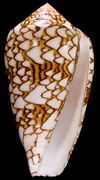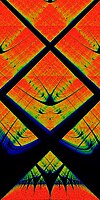Leon O. Chua: Difference between revisions
fixed bad math |
m cleanup |
||
| Line 38: | Line 38: | ||
}} |
}} |
||
'''Leon Ong Chua''' ({{IPAc-en|ˈ|tʃ|w|ɑː}}; {{zh|c=蔡少棠|poj=Chhòa Siáu-tông|p=Cài Shǎotáng|w=Ts'ai Shao-t'ang}}; born June 28, 1936) is an American electrical engineer |
'''Leon Ong Chua''' ({{IPAc-en|ˈ|tʃ|w|ɑː}}; {{zh|c=蔡少棠|poj=Chhòa Siáu-tông|p=Cài Shǎotáng|w=Ts'ai Shao-t'ang}}; born June 28, 1936) is an American [[electrical engineer]] and [[computer scientist]]. He is a professor in the [[electrical engineering]] and [[computer science]]s department at the [[University of California, Berkeley]], which he joined in 1971. He has contributed to [[nonlinear]] [[circuit theory]] and [[cellular neural network]] (CNN) theory.<ref>{{cite journal | last = Chua | first = L.O. | title = Cellular neural networks: theory | journal = IEEE Transactions on Circuits and Systems | volume = CAS-35 | issue = 10 | pages = 1257–1272 | publisher = [[IEEE]] | date = October 1988 | accessdate = 2008-05-03}}</ref> He is also the inventor and namesake of [[Chua's circuit]]<ref>{{cite journal | last = Matsumoto | first = Takashi | title = A Chaotic Attractor from Chua's Circuit | journal = IEEE Transactions on Circuits and Systems | volume = CAS-31 | issue = 12 | pages = 1055–1058 | publisher = [[IEEE]] | date = December 1984 | url = http://www.eecs.berkeley.edu/~chua/papers/Matsumoto84.pdf | accessdate = 2008-05-01}}</ref> one of the first and most widely known circuits to exhibit [[chaos theory|chaotic]] behavior, and was the first to conceive the theories behind, and postulate the existence of, the [[memristor]].<ref>{{cite journal | last = Chua | first = Leon O. | authorlink = Leon O. Chua | title = Memristor - The Missing Circuit Element | journal = IEEE Transactions on Circuits Theory | volume = 18 | issue = 5 | pages = 507–519 | publisher = [[IEEE]] | date = September 1971 | url = http://ieeexplore.ieee.org/iel5/8147/23413/01083337.pdf | accessdate = 2008-05-01 | doi = 10.1109/TCT.1971.1083337}}</ref> Thirty-seven years after he predicted its existence, a working solid-state memristor was created by a team led by [[R. Stanley Williams]] at Hewlett Packard.<ref name="Addee2008_05">"'Without Chua's circuit equations, you can't make use of this device,' says Williams. " {{cite web|url=http://www.spectrum.ieee.org/may08/6207|title=The Mysterious Memristor|author=Sally Addee|publisher=[[IEEE Spectrum]]|date=May 2008}}</ref><ref>{{cite web|url=http://www.eetimes.com/showArticle.jhtml?articleID=207403521|title= 'Missing link' memristor created: Rewrite the textbooks?|author=R. Colin Johnson|publisher=[[EE Times]]|date=2008-04-30}}</ref> |
||
==Early life and education== |
==Early life and education== |
||
Revision as of 07:11, 9 July 2016
Leon O. Chua | |
|---|---|
| Born | Leon Ong Chua June 28, 1936 |
| Citizenship | United States |
| Alma mater | Mapúa Institute of Technology Massachusetts Institute of Technology University of Illinois, Urbana-Champaign |
| Known for | Nonlinear circuit theory Cellular neural networks Memristor Chua's circuit Chaotic digital CDMA |
| Children | Amy Chua, Michelle, Katrin, Cynthia |
| Awards | IEEE Browder J. Thompson Memorial Prize Award(1967) IEEE W.R.G. Baker Prize Paper Award (1973) |
| Scientific career | |
| Fields | Electrical Engineering Electronics and Communication Engineering Computer Science |
| Institutions | University of California, Berkeley |
| Doctoral advisor | Mac Van Valkenburg |
| Doctoral students | See: Ph.D. Dissertations supervised by Chua |
Leon Ong Chua (/ˈtʃwɑː/; Chinese: 蔡少棠; pinyin: Cài Shǎotáng; Wade–Giles: Ts'ai Shao-t'ang; Pe̍h-ōe-jī: Chhòa Siáu-tông; born June 28, 1936) is an American electrical engineer and computer scientist. He is a professor in the electrical engineering and computer sciences department at the University of California, Berkeley, which he joined in 1971. He has contributed to nonlinear circuit theory and cellular neural network (CNN) theory.[1] He is also the inventor and namesake of Chua's circuit[2] one of the first and most widely known circuits to exhibit chaotic behavior, and was the first to conceive the theories behind, and postulate the existence of, the memristor.[3] Thirty-seven years after he predicted its existence, a working solid-state memristor was created by a team led by R. Stanley Williams at Hewlett Packard.[4][5]
Early life and education
A first generation Chinese American, Chua and his twin sister grew up as members of the Chinese ethnic minority in the Philippines[6] under the reign of the Empire of Japan during World War II. Of Hoklo ancestry, his parents immigrated from Fujian province.[7] He earned his BSEE degree from Mapúa Institute of Technology in the Philippines in 1959, then emigrated to the United States on a scholarship to the Massachusetts Institute of Technology, where he earned an MSEE degree in 1961. He then earned a Ph.D from the University of Illinois, Urbana-Champaign in 1964. His PhD thesis was entitled Nonlinear Network Analysis—The Parametric Approach. Over the ensuing years, he has received eight honorary doctorates.
Chua has four daughters; the eldest, Amy Chua (a Professor of Law at Yale University.[6]), Michelle, Katrin (a Professor of Medicine at Stanford University), and Cynthia (Cindy, a Special Olympics Gold medalist). In addition to his four daughters, Chua has seven grandchildren.1
Career
Chua was a member of the faculty at Purdue University from 1964 to 1970 before joining Berkeley in 1971. His current research interests include cellular neural/nonlinear networks, nonlinear circuits and systems, nonlinear dynamics, bifurcation theory, and chaos theory. He was the Editor of The International Journal of Bifurcation and Chaos until 2009, and is now the Honorary Editor of this journal.
Awards and honors
- Member of the Academy of Europe, http://www.ae-info.org/ae/User/Chua_Leon
- Doctor Honoris Causa from the École Polytechnique Fédérale de Lausanne, Switzerland (1983) [8]
- Honorary Doctorate from the University of Tokushima, Japan (1984)
- Honorary Doctorate from the Technische Universität Dresden, Germany (1992)
- Doctor Honoris Causa from the Technical University of Budapest, Hungary (1994)
- Doctor Honoris Causa from the University of Santiago de Compostela, Spain (1995)
- Doctor Honoris Causa from the Goethe University Frankfurt, Germany (1996)
- Doctor Honoris Causa from the Gheorghe Asachi Technical University of Iaşi, Romania (1997)
- Doctor Honoris Causa from the University of Catania, Italy (2000)
- Doctor Honoris Causa from the AGH University of Science and Technology, Poland (2003)
- Doctor Honoris Causa from the University of Le Havre, France (2009)
- Doctor Honoris Causa from the KU Leuven, Belgium (2013)
- Doctor of Science Honoris Causa from the Hong Kong Polytechnic University, Hong Kong (2014)
- Doctor Honoris Causa from the Polytechnic University of Turin, Italy (2015)[9]
- IEEE Browder J. Thompson Memorial Prize Award (1967) [10]
- IEEE Guillemin-Cauer Award (1972, 1985, 1989) [11]
- IEEE W.R.G. Baker Prize Paper Award (1973), for the paper "Memristor: The Missing Circuit Element" in IEEE TRANSACTIONS on Circuit Theory, September 1971 [12]
- IEEE Neural Networks Pioneer Award (2000) [13]
- IEEE Gustav Robert Kirchhoff Award (2005), For seminal contributions to the foundation of nonlinear circuit theory, and for inventing Chua's Circuit and Cellular Networks, each spawning a new research area. [14]
- M. E. Van Valkenburg Award (1995 and 1998)
- IEEE Circuits and Systems Society Vitold Belevitch Award (2007), For seminal contributions to nonlinear circuit theory, the first mathematically proven physical implementation of Chaos (Chua circuit), the local activity principle as the root of complexity, the cellular neural/nonlinear network principle and basic theory, and the qualitative theory of complexity in 1D cellular automata.[15]
- 2010 Guggenheim Fellowship
References
- ^ Chua, L.O. (October 1988). "Cellular neural networks: theory". IEEE Transactions on Circuits and Systems. CAS-35 (10). IEEE: 1257–1272.
{{cite journal}}:|access-date=requires|url=(help) - ^ Matsumoto, Takashi (December 1984). "A Chaotic Attractor from Chua's Circuit" (PDF). IEEE Transactions on Circuits and Systems. CAS-31 (12). IEEE: 1055–1058. Retrieved 2008-05-01.
- ^ Chua, Leon O. (September 1971). "Memristor - The Missing Circuit Element" (PDF). IEEE Transactions on Circuits Theory. 18 (5). IEEE: 507–519. doi:10.1109/TCT.1971.1083337. Retrieved 2008-05-01.
- ^ "'Without Chua's circuit equations, you can't make use of this device,' says Williams. " Sally Addee (May 2008). "The Mysterious Memristor". IEEE Spectrum.
- ^ R. Colin Johnson (2008-04-30). "'Missing link' memristor created: Rewrite the textbooks?". EE Times.
- ^ a b "Lance Morrow (2007-09-18). "How to Rule the World". New York Times.
- ^ Chua, Amy (2011). Battle Hymn of the Tiger Mother. Penguin Press. p. 14. ISBN 978-1-59420-284-1.
- ^ Jorge Luis Moiola (2001). "Bifurcation Control: Methodologies and Applications" (PDF). Latin American Applied Research.
- ^ "LAUREA MAGISTRALE AD HONOREM TO PROF. LEON O. CHUA". Retrieved May 21, 2015.
- ^ "IEEE Browder J. Thompson Memorial Prize Award Recipients" (PDF). IEEE. Retrieved December 26, 2010.
- ^ "Guillemin-Cauer Award". IEEE.
- ^ "IEEE W.R.G. Baker Prize Paper Award Recipients" (PDF). IEEE. Retrieved December 25, 2010.
- ^ "3.1 Leon Chua receives IEEE Gustav Robert Kirchhoff Award". IEEE Control Systems Society. May 2005.
- ^ "IEEE Gustav Robert Kirchhoff Award Recipients" (PDF). IEEE. Retrieved May 31, 2011.
- ^ "2007 Awards" (PDF). IEEE Circuits and Systems Society.
External links
- 1936 births
- Living people
- American computer scientists
- American electrical engineers
- American people of Chinese descent
- Chaos theorists
- Fellow Members of the IEEE
- Filipino emigrants to the United States
- Filipino people of Chinese descent
- Guggenheim Fellows
- Mapúa Institute of Technology alumni
- Members of Academia Europaea
- Massachusetts Institute of Technology alumni
- Purdue University faculty
- Twin people from the Philippines
- Twin people from the United States
- University of California, Berkeley faculty
- University of Illinois at Urbana–Champaign alumni


